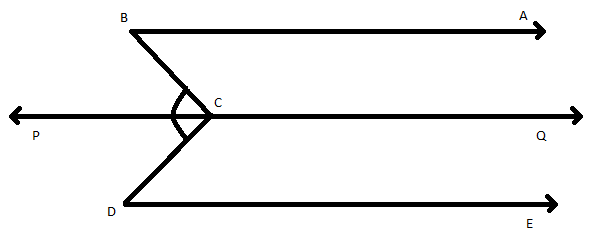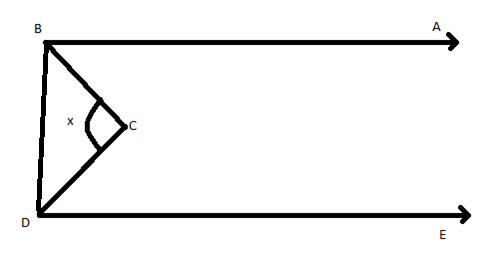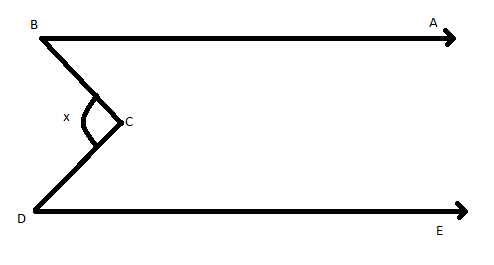
Answer
440.7k+ views
Hint: We can draw a line passing through C, parallel to the parallel lines. This divides the angle into two parts. Then using the concept of parallel lines intersected by a transversal, we can find the measure of each part of the angle. Then we get the value of x by adding them.
Complete step by step answer:
We can draw the figure given in the question. As $AB\parallel ED$, and then draw a line PQ parallel to AB and ED.

We can draw the figure given in the question. As $AB\parallel ED$, we can draw line PQ parallel to AB and ED.
We need to find x. It is the measure of angle BCD.
From the figure, the line PQ divides $\angle BCD$ into two parts. So, we can write,
$\angle BCD = \angle BCP + \angle PCD$.. (1)
Now we can consider the parallel lines AB and PQ. It is cut by the transversal BC.
From the figure, we can say that the $\angle ABC$ and $\angle BCP$ are alternate interior angles. We know that alternate interior angles when 2 parallel lines are intersected by a transversal are equal.
$ \Rightarrow \angle ABC = \angle BCP$
It is given that, \[\angle ABC = 30^\circ \].
\[ \Rightarrow \angle BCP = 30^\circ \] … (2)
Now we can consider the parallel lines DE and PQ. It is cut by a transversal CD.
Here, $\angle EDC$ and $\angle DCP$ are alternate interior angles. We know that alternate interior angles when 2 parallel lines are intersected by a transversal are equal.
$ \Rightarrow \angle EDC = \angle DCP$
But it is given that, \[\angle EDC = 70^\circ \]
$ \Rightarrow \angle DCP = 70^\circ $… (3)
On substituting (2) and (3) in (1), we get,
$ \Rightarrow \angle BCD = 30^\circ + 70^\circ $
$ \Rightarrow \angle BCD = 100^\circ $
$ \Rightarrow x = 100^\circ $
Therefore, value of x is $100^\circ $.
Note: Alternate solution is given by, in the given figure We can join the points B and D to form a triangle BCD.

By angle sum property, $\angle BDC + \angle DBC + x = 180^\circ $…(a)
As AB and DE are parallel and BD is intersected, $\angle ABD$ and $\angle BDE$ are the alternate interior angles and they are supplementary.
$ \Rightarrow \angle ABD + \angle BDE = 180^\circ $
From the figure we say that, $\angle ABD = \angle ABC + \angle CBD$ and $\angle BDE = \angle CDE + \angle BDC$.
$ \Rightarrow \angle ABC + \angle CBD + \angle CDE + \angle BDC = 180^\circ $
It is given that, \[\angle ABC = 30^\circ \] and \[\angle EDC = 70^\circ \]
$ \Rightarrow 30^\circ + \angle CBD + 70^\circ + \angle BDC = 180^\circ $
On rearranging, we, get.
\[ \Rightarrow \angle CBD + \angle BDC = 180^\circ - 30^\circ - 70^\circ \]
\[ \Rightarrow \angle CBD + \angle BDC = 80^\circ \] .
On substituting this in (a), we get,
$80^\circ + x = 180^\circ $
$ \Rightarrow x = 180^\circ - 80^\circ $
$ \Rightarrow x = 100^\circ $
Therefore, value of x is $100^\circ $
Complete step by step answer:
We can draw the figure given in the question. As $AB\parallel ED$, and then draw a line PQ parallel to AB and ED.

We can draw the figure given in the question. As $AB\parallel ED$, we can draw line PQ parallel to AB and ED.
We need to find x. It is the measure of angle BCD.
From the figure, the line PQ divides $\angle BCD$ into two parts. So, we can write,
$\angle BCD = \angle BCP + \angle PCD$.. (1)
Now we can consider the parallel lines AB and PQ. It is cut by the transversal BC.
From the figure, we can say that the $\angle ABC$ and $\angle BCP$ are alternate interior angles. We know that alternate interior angles when 2 parallel lines are intersected by a transversal are equal.
$ \Rightarrow \angle ABC = \angle BCP$
It is given that, \[\angle ABC = 30^\circ \].
\[ \Rightarrow \angle BCP = 30^\circ \] … (2)
Now we can consider the parallel lines DE and PQ. It is cut by a transversal CD.
Here, $\angle EDC$ and $\angle DCP$ are alternate interior angles. We know that alternate interior angles when 2 parallel lines are intersected by a transversal are equal.
$ \Rightarrow \angle EDC = \angle DCP$
But it is given that, \[\angle EDC = 70^\circ \]
$ \Rightarrow \angle DCP = 70^\circ $… (3)
On substituting (2) and (3) in (1), we get,
$ \Rightarrow \angle BCD = 30^\circ + 70^\circ $
$ \Rightarrow \angle BCD = 100^\circ $
$ \Rightarrow x = 100^\circ $
Therefore, value of x is $100^\circ $.
Note: Alternate solution is given by, in the given figure We can join the points B and D to form a triangle BCD.

By angle sum property, $\angle BDC + \angle DBC + x = 180^\circ $…(a)
As AB and DE are parallel and BD is intersected, $\angle ABD$ and $\angle BDE$ are the alternate interior angles and they are supplementary.
$ \Rightarrow \angle ABD + \angle BDE = 180^\circ $
From the figure we say that, $\angle ABD = \angle ABC + \angle CBD$ and $\angle BDE = \angle CDE + \angle BDC$.
$ \Rightarrow \angle ABC + \angle CBD + \angle CDE + \angle BDC = 180^\circ $
It is given that, \[\angle ABC = 30^\circ \] and \[\angle EDC = 70^\circ \]
$ \Rightarrow 30^\circ + \angle CBD + 70^\circ + \angle BDC = 180^\circ $
On rearranging, we, get.
\[ \Rightarrow \angle CBD + \angle BDC = 180^\circ - 30^\circ - 70^\circ \]
\[ \Rightarrow \angle CBD + \angle BDC = 80^\circ \] .
On substituting this in (a), we get,
$80^\circ + x = 180^\circ $
$ \Rightarrow x = 180^\circ - 80^\circ $
$ \Rightarrow x = 100^\circ $
Therefore, value of x is $100^\circ $
Recently Updated Pages
How many sigma and pi bonds are present in HCequiv class 11 chemistry CBSE

Mark and label the given geoinformation on the outline class 11 social science CBSE

When people say No pun intended what does that mea class 8 english CBSE

Name the states which share their boundary with Indias class 9 social science CBSE

Give an account of the Northern Plains of India class 9 social science CBSE

Change the following sentences into negative and interrogative class 10 english CBSE




